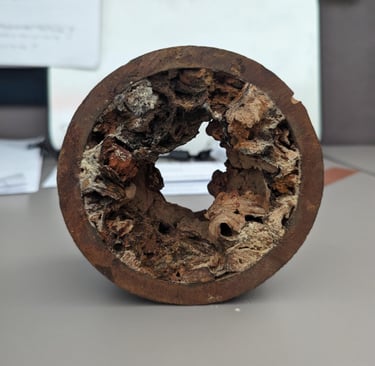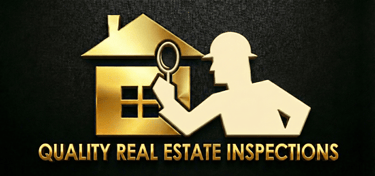The Hidden Hazard: Cast-Iron Sewer Piping in Central Florida
The Hidden Hazard: Cast-Iron Sewer Piping in Central Florida
Tariq AbouAdma
11/10/20254 min read
Why old piping systems are a growing risk
Many homes in Central Florida—especially those built before the mid-1970s—were constructed with sewer and drain piping made of cast iron. At the time, cast-iron was a standard choice: strong, heavy, and widely available. Whitt Inspections, LLC+2Island Pineapple Realty+2
But as decades pass, the environment and usage conditions in Florida make these pipes vulnerable. Some key factors:
Florida’s climate: Humid, salty air—especially in coastal or near-coastal Central Florida—accelerates external corrosion of pipe joints or buried pipes. Burton Plumbing LLC+1
Shifting soils & slab-foundation homes: Much of Central Florida is built on sandy or shifting soils; homes on slabs mean the sewer piping often runs beneath concrete, with limited access and added stress. Burton Plumbing LLC+1
Interior corrosion & chemical attack: Waste, gases (such as hydrogen sulfide) and corrosive environments can deteriorate cast-iron from the inside out, creating thinning, cracking or collapse. Whitt Inspections, LLC
Aging infrastructure: According to inspection industry sources, cast iron piping in homes often reaches serious wear well before the “textbook” lifespan of 40-60 years due to Florida-specific conditions. Whitt Inspections, LLC+1
In short: while cast iron once seemed a long-term solution, in Florida’s particular conditions its “hidden lifespan” may be shorter than expected. And the result? Unseen deterioration, increasing risk of backups, leaks, costly repairs and property damage.
Common Warning Signs in Central Florida Homes
If your home is older (built in the 1960s/70s or earlier) and still uses cast-iron sewer or drain piping, watch for these tell-tale signs:
Multiple drains throughout the house slow down or clog frequently (not just one fixture). Island Pineapple Realty+1
Gurgling sounds when flushing toilets or using drains—indicative of restricted flow or blocked line. Hers and His Plumbing+1
Persistent sewer or “rotten egg” smells inside the home or near baseboards, even when drains appear clear. Broward Plumbing+1
Wet spots or lush green patches in the yard near the foundation—may signal a leaking underground sewer line. Burton Plumbing LLC+1
Visible rusting, flaking or discolored water if the pipe is accessible, or soft spots in tiled floors over slab‐areas. Broward Plumbing
Ignoring these signs may lead to sudden failure of a sewer line, resulting in a major disruption: removal of slabs/flooring, excavation across the house, mold or water damage, and substantial cost. Pipeflow Solutions+1
Why Replacement or Repair Is Challenging in Central Florida
The combination of older homes, slab foundations and sandy soils creates particular challenges:
The sewer line often runs under the slab and through concrete flooring—excavation means major disruption (walls, floors, landscaping). Island Pineapple Realty+1
Home‐insurance policies may exclude “gradual damage” from corrosion or may significantly limit coverage for pipe replacement. Trenchless Epoxy Lining
When failure happens suddenly (rather than gradually), the damage may already be significant—foundation undermining, soil erosion, mold, or backup of sewage. Pipeflow Solutions
Thus, waiting until “it fails” often means higher cost, more disruption—and worse outcomes for homeowners.
Mitigation Strategies: What Homeowners Should Do
For homeowners in Central Florida, QRES LLC recommends a proactive and informed approach:
1. Inspection & diagnosis
Hire a licensed plumber to perform a camera sewer‐scope inspection of your main drain/sewer line. This visual inspection reveals condition of pipes—cracks, corrosion, root intrusion, offsets. Island Pineapple Realty+1
Review your home’s construction date, soil/footprint details and plumbing history. If the home was built before the 1970s and still has original waste-line piping, assume risk.
Ask for documentation of pipe condition (video footage, stills) and any penetrations or repairs.
2. Choose the right repair method
Depending on condition of the existing cast-iron pipe and budget, options include:
Trenchless pipe lining (CIPP – cured in place pipe): This installs a new liner inside the existing pipe, without major excavation. Minimal disruption, less cost, retaining existing orientation. Pipeflow Solutions+1
Full pipe replacement (excavation): When the corrosion/structural failure is severe (collapsed sections, major offsets), full removal and replacement may be required—more costly, more disruptive. Burton Plumbing LLC
Localized spot repair: If only certain sections are damaged (e.g., near slab edge, joint failure), targeted excavation or repair may suffice, but this still needs professional judgement.
3. Maintain and monitor
Schedule periodic inspections (for example every 5-10 years) of older piping, especially in high-risk homes. As noted: corrosion is an ongoing process. Whitt Inspections, LLC
Keep an eye on warning signs described above; don’t delay when multiple indicators show up.
Maintain surrounding landscaping and drainage: ensure tree roots are controlled (roots often invade older sewer lines), and yard drainage doesn’t allow standing water near the slab which can exacerbate soil shift and pipe stress. Hers and His Plumbing
Document all repairs/work performed, keep records. This will help if you ever sell the home (buyers will often request plumbing/sewer condition) or if you make an insurance claim.
4. Work with insurance and contractors
Review your homeowners’ insurance policy: understand what is and is not covered (e.g., “gradual corrosion” may be excluded). Insurance Journal
When hiring a contractor, choose one experienced in older Florida homes, slab foundations and trenchless technology (if applicable). Ask for references, warranties, and ask for full cost comparisons of options.
Expect a proper estimate—including cleanup/restoration of flooring, slab repair, landscaping, etc—not just piping alone.
Why QRES LLC Is Your Trusted Partner
At QRES LLC, we understand the unique plumbing challenges facing homes in Central Florida: aging infrastructure, slab‐foundation homes, sandy soils, and the Florida climate. We bring together:
Licensed plumbing professionals experienced in cast-iron sewer line replacement/repair
Specialized equipment (camera scoped inspections, hydro-jetting, trenchless lining options)
Transparent communication: we show you video evidence of condition, review options and help you choose the best path for your budget and condition
Minimally disruptive solutions: whenever feasible we prioritize trenchless methods so your floors, tile, landscaping stay intact
Documentation and support: we provide the reports and documentation you may need for resale or insurance purposes
If you suspect your home may have original cast-iron sewer piping—or if you’ve experienced the warning signs described above—it’s wise to act now rather than later. The cost and disruption of waiting until failure is substantially higher.
Call us today for a no-obligation video sewer inspection and let us help you protect your home, your investment and your peace of mind.
Resources


Inspection Services:
Pre Purchase Inspections (For Buyers Commercial And Residential )
Wind Mitigation Inspection (For Insurance )
4 Points Inspections (For Insurance )
Roof Condition Certification (For Insurance )
Building Plan with dimensions
Pre Drywall Inspection ( New Construction Commercial And Residential )
Pre Listing Inspection ( For Seller Commercial And Residential )
Pool Inspection
Sewer Scope Inspection
Lead Paint Inspection
Mold Inspection
WDO - We Schedule with our sister company
Contact
321-222-3116
© 2025. All rights reserved.
Address:
1317 Edgewater Dr #1442, Orlando, FL 32804
7305 Houston Ave w, Winter Park FL 32792
Blog Posts List
Common Problems in Homes Built in the 60s and How to Mitigate Them
Commercial Property Inspections Are Essential—Don’t Buy Without One
Winter Park, Florida Real Estate: A Hot Market with Timeless Charm — Powered by QRESLLC.com
Understanding PEX Piping: A Comparison of Pre-2010 and Post-2010 Installations
High-Risk Discovery: Why the Challenger Electrical Panel is a Major Red Flag on Your Home Inspection
Time Bomb Plumbing? Why Buyers Need a Home Inspection to Spot Polybutylene Pipes ⚠️
Secure Your Investment: Why Property Inspections are Non-Negotiable Before You Buy 🏡🏢
Hidden Fire Risk: Why Your Home Inspector Must Check for Single-Strand Aluminum Wiring 🔥
Clay Tile Roof: The Buyer's Guide to Lifespan, Maintenance, and Home Inspection Red Flags
Mastering the Art of Negotiating Property Prices in Central Florida
Tile Trouble: The Hidden Problems of Installing Solar Panels on Clay Roofs 🧱⚡
A Homeowner’s Guide to Roofing in Florida: Lifespan, Insurability & Maintenance
Understanding Electrical Wiring in Florida Homes: Old vs. New and What It Means for Insurance
The Hidden Hazard: Cast-Iron Sewer Piping in Central Florida
VA Mortgage Loan: Qualifications, Steps, and Expert Insights for Homebuyers
Living in Orlando ZIP Code 32828: Neighborhood Guide, Schools, Home Types & Common Building Issues
Living in Zip Code 32792: A Complete Guide to Winter Park’s Vibrant Community
Living in Oviedo, Florida (32765, 32766, 32762): A Complete Guide for Homebuyers and Residents
Owning a Piece of Florida History: Key Challenges and Mitigation for 1960s Central Florida Homes
🐜 The Silent Destroyers: A Central Florida Homeowner’s Guide to Termites
